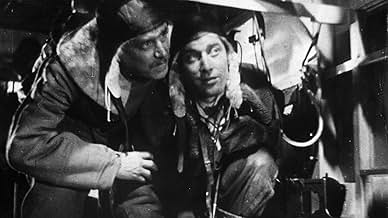NOTE IMDb
6,4/10
370
MA NOTE
1937, pendant la guerre civile espagnole. La lutte des Républicains contre l'armée fasciste du général Franco. Peut être considéré comme un témoignage romancé du réalisateur et écrivain Andr... Tout lire1937, pendant la guerre civile espagnole. La lutte des Républicains contre l'armée fasciste du général Franco. Peut être considéré comme un témoignage romancé du réalisateur et écrivain André Malraux, qui a rejoint les Républicains en 1936.1937, pendant la guerre civile espagnole. La lutte des Républicains contre l'armée fasciste du général Franco. Peut être considéré comme un témoignage romancé du réalisateur et écrivain André Malraux, qui a rejoint les Républicains en 1936.
- Récompenses
- 1 victoire au total
Histoire
Le saviez-vous
- AnecdotesRe-titled 'Man's Hope', this film's earliest documented telecast took place in Cincinnati Sunday 2 October 1949 on WKRC (Channel 11).
- ConnexionsEdited into Histoire(s) du cinéma: Une vague nouvelle (1999)
- Bandes originalesFuneral march
Composed by Darius Milhaud
Commentaire à la une
This film is based on one chapter of André Malraux's novel L'ESPOIR (HOPE) published in 1937. The Spanish title was SIERRA DE TERUEL and the two English titles used from 1945 on were MAN'S HOPE and DAYS OF HOPE. But the French title is ESPOIR ('HOPE'). The film was directed by Malraux himself, aided by the Russian Boris Peskine. Malraux also co-wrote the screenplay. The film concerns real events which took place at Teruel in north-eastern Spain in 1937, and was shot on location in 1938, with a Spanish cast and more than one thousand local peasants. The film is so realistic it is practically a dramatized documentary. The film was financed by the Spanish Second Republic. Malraux himself joined the Republicans in 1936 to fight against Franco. He was a commandant of an air squadron, and hence the extremely dramatic shots of aerial combat and the story focusing on a brave bombing raid. A great deal of genuine 1938 war footage is used, which is well integrated into the drama, and some of which seems to have been of the actual bombing raid itself. The film was finished in 1939 and shown a few times in Paris. As a piece of history, the film is priceless, because it is entirely authentic and was made only months after the real events. The Vichy regime in France and the Franco regime in Spain seized and destroyed all copies of the film which could be found. But one print secretly survived, which surfaced in 1945, and was shown in Paris then. The film I have seen was of that one surviving print which was restored in 2003. The film was never entirely finished, and there are frequent bridging texts linking the filmed episodes in order to make the story continuous and complete. These texts are original, as it was clearly impossible to film everything called for in the script because of the Franco regime's control of Spain. Although the film certainly had propaganda value, I would not call it a propaganda film, because its integrity is too great for such a categorisation. The language of the film is Spanish, but I have seen it with English subtitles (from Movie Detective). This is as far from a Hollywood war film as anyone could get. Everything about the film's look and impact is real and authentic. Whether the story has been somewhat romanticised or not we may never know, but that hardly matters. One feels one is really there in those small Spanish towns with deserted streets and a few straggling Republicans sharing a single military rifle and otherwise only having their hunting rifles, and precious few of those. They search all over town to find a single car which they can 'borrow' for a daring raid. Brave men suddenly fall dead and others survive, showing the randomness of war. The aerial scenes are amazing. They need to blow up a crucial bridge and a new air field. At one point a plane is flown by a man who has not flown since 1918, 19 years earlier; he crash lands because he was not allowed his two hours of practice to get back in the swing of things. But he survives to continue to serve bravely. We see incomplete planes in an improvised hangar with their fronts off, waiting for the engines which never arrived. Everything about the war waged by the Republicans was improvised, for lack of funds and supplies, in their struggle against Franco's army which was so amply funded and supplied by the Hitler regime. Even the way to the enemy airfield is only made possible because a local peasant from the adjoining village leads the pilot of the bomber by means of spotting the lanes and fields from the air, interrupted by clouds. This film was influenced to a certain extent by Russian cinema, with some dramatic shots of the heroic 'people'. But mainly, action dominates. No one appears to be acting, and although most people in the film are amateurs, that only adds to the realism. What an amazing film this is!
- robert-temple
- 16 nov. 2023
- Permalien
Meilleurs choix
Connectez-vous pour évaluer et suivre la liste de favoris afin de recevoir des recommandations personnalisées
Détails
- Durée1 heure 28 minutes
- Couleur
- Rapport de forme
- 1.37 : 1
Contribuer à cette page
Suggérer une modification ou ajouter du contenu manquant

Lacune principale
What is the English language plot outline for Espoir - Sierra de Teruel (1940)?
Répondre








